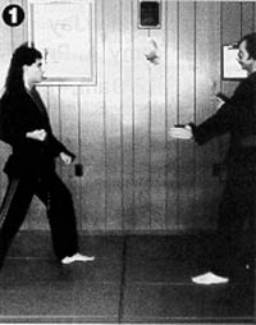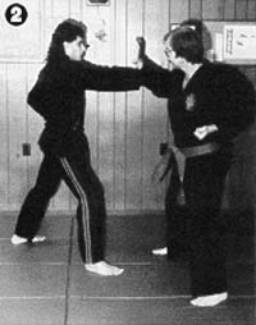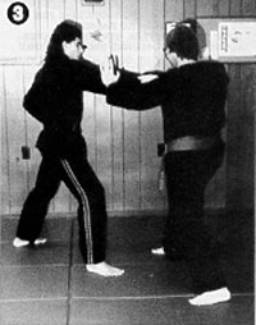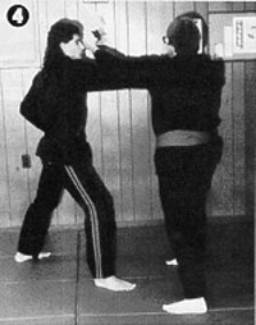|
|
|
Okinawan karate’s Principle
of Continuous Attack
Strike and Strike Again Until the Opponent is Finished
By William Durbin
Renzoku ken (continuous fist) is an ancient combat
principle developed in Okinawa. Although it is still found today in some
shorin-ryu and goju-ryu karate schools, few practice the maneuver as it was
originally developed by the warriors of Okinawa.
These warriors practiced an art called bushi-te, which was
designed to allow them to defend themselves in any situation. They were less of
a standing army for repelling invaders, and more of a peacekeeping force to deal
with criminals and provide security for the king. Thus, the art they practiced
needed to meet various criteria.
First, the art had to have excellent grappling applications for use in subduing and restraining prisoners. Next, it needed to include the devastating token (one-strike kill) technique for life-or-death situations. It also addressed vital-point strikes, so the warriors would know where to deliver blows which could severely injure or kill an attacker. And finally, for those situations when grappling was ineffective and the one-strike kill was foiled, the art provided a follow-up attack known as renzoku ken.
Renzoku ken is a process in which basic techniques of ikken are expanded so that if the first strike is unable to stop an attack, the defender follows up immediately with a natural flow of techniques. When kempo karate was first brought to the United States, the art's most noticeable attribute was renzoku ken, so much so that as American styles developed, many were shaped around this principle. Yet the biggest complaint levied against these systems has been that the techniques which compose the renzoku ken series lack focus.




In this sequence, an Okinawan karate stylist (right) demonstrates the "continuous fist" concept. He faces off (1) with an opponent and uses (2) an open-hand block to deflect a punch. He then grabs the punching arm and delivers (3) a palm-heel smash to the elbowjoint, followed (4) by a backfist to the opponents face.
In the bushi-te practiced by ancient Okinawan warriors,
each renzoku ken technique was fully focused, as if it were the only technique
needed. If the technique was blocked or dodged, the bushi-te stylist would flow
into another technique which was a natural extension of the original movement.
The result was an extremely effective series of techniques which kept an
attacker on the defensive, and eventually overpowered him.
Renzoku ken serves as an effective follow-up maneuver to a
grappling technique. The Okinawan warriors realized that if their grappling
moves failed, they would be in close proximity to their opponent and vulnerable
to a counterattack. Thus, the bushi-te exponent was prepared to transition
naturally from the grappling technique to a withering barrage of strikes.
Students can practice this maneuver by using a drill known as toide, in which
one person attacks while the defender applies a joint lock. then flows into
whatever counterstrike comes most naturally. Students can take the drill a step
further and conduct a give-and-take session, whereby several techniques are
exchanged before a final resolution is achieved.
Kiyojute-ryu kempo utilizes both the renzoku ken and toide
training principles of bushi-te. And, as in the ancient method, most of the
training is performed in a freestyle manner. Generally, only the attacker's
first move is planned, while the ensuing follow-up techniques flow naturally.
Renzoku ken can only enhance one's self-defense training.
If a karate practitioner only practices ikken methods, he begins to believe that
one strike is all that is necessary to end a real confrontation. All too often,
however, it is the second or third strike that actually ends an altercation on
the street. Thus the importance of renzoku ken training.
One's body posture dictates the follow-up techniques used
in renzoku ken; the practitioner should deliver any blow that can be freely
employed. The defender should cease his counterattack if and when the attacker
gives up the fight. Some karate systems include striking combinations which do
not follow natural body movement and direct students to carry each technique
through to the end of the series. If, however, a movement is not a natural
extension of the practitioner's previous maneuver, it probably will not be
effective and could put the defender into a precarious situation. More
importantly, if the practitioner continues a series of self-defense strikes
after his attacker either capitulated or is incapable of further aggression, he
has (according to the laws of most states) become the aggressor and can be
charged accordingly. Your right to defend yourself ends when an attacker has
halted his aggression. It is therefore important to learn not only how to follow
up your initial defense, but how to stop at the appropriate time. This is one
reason why freestyle renzoku ken practice is so valuable.
Renzoku ken is one of the most important principles of the ancient Okinawan martial arts and has greatly influenced the development of American combat systems. When learned properly, renzoku ken will allow modern martial artists to respond with the same effectiveness enjoyed by the ancient Okinawan warriors of bushi-te.